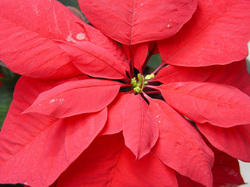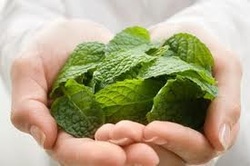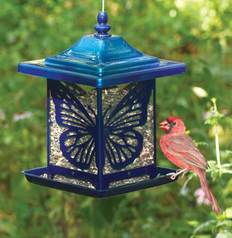|
Circa 1997 A native of the American continent, the Poinsettia was discovered in 1828 in Mexico by Dr. Joel Roberts Poinsett of Charleston, South Carolina. Dr. Poinsett spent four years as the United States' first minister to that country. The Mexican people called the flower " Flor de la Noche Buena" ( Flower of the Holy Night or of Christmas Eve.) They believed that when blood fell on the earth from the broken heart of a yound girl, a Poinsettia plant grew from each drop. Dr. Poinsett took his discovery to a friend in California where the Poinsettia thrived. Today the region twenty miles north of San Diego is known as the "Poinsettia Belt." Description: A showy species with oval to elliptical, or bold, mid-green leaves. The spectacular coloration is found in the scarlet leaf-like bracts which grow beneath the small, yellow cluster of flowers. Care: Poinsettias need bright light to hold their color, and adequate humidity to prevent the bottom leaves from dropping off. They need good drainage and water daily. If you want to have your Poinsettia another season try sinking the pot in a sunny garden after frost danger has passed. Prune the stemms severely, water and fertilize regularly until the cool nights arrive. Lift the pot and bring it indoors again to a cool, sunny window.
0 Comments
Without mint a Kentucky Derby favorite would just be a julep. Leave off the mint and all you have is the pepper. And how good would lamb be without a side of mint jelly? Mint is a popular herb for cooking, making candy, creating medicinal remedies, and planting in a garden.
Circa 1997 Spring, 1975 - age 11
While riding home from Sunday morning mass with Dad, Mom, Grandpa, and Grandma, a fancy landscape truck, trailer and tractor passed by us at Post and Washington. I mentioned to everyone that that's what I want to do. Summer, 1976 Dan Stoeffler and I started collecting old lawn mowers and motors storing them in his dad's garage nest to the Cumberland Post Office. One old mower was hauled out of Lake Freeman after it was drained that fall. We never made any money repairing mowers but we sold our whole inventory for $120.00 1976 was also the year that Dad bought our first riding mower that he allowed me to use. I mowed 3-6 lawns per week. When winter arrived I bought my first snow plow for the mower. Summer, 1978 - age 14 Dan Stoeffler, Jon Morris and I started working for Dennis Fisher mainly doing lawn maintenance. We all pushed mowed 8-10 hours per day for $2.50 per hour. We had a lot of fun traveling around the city all day but we worked like men. Spring, 1979 - age 15 I borrowed $1,500.00 from the bank to purchase my first mower. I mowed for my regular customers and worked as a subcontractor for Dennis for $10.00 per hour. This was the first time self-employment came to mind. Fall, 1979 After lying about my age, I was hired by Harlan Industries ( the "rat factory"). I worked from 4:00 - 11:00pm daily. I liked the money but I should have been studying and socializing. I bought my first truck that year - a 1967 Bronco. Summer, 1980 - age 16 I basically worked for myself mowing lawns and doing whatever. Fall, 1980 I sold the Bronco and bought a 1977 F150 4x4 and snow plow. I also enrolled in a horticulture program at Walker Career Center taught by Mr. Phil Pitts. Summer, 1981 I continued working for myself. Fall, 1981 I continued in horticulture January, 1982 I graduated mid-term, landed some more accounts, bought three walk-behind mowers, and hired my first employees. And the rest is Ski Landscape history. Special thanks to all of you who have made my dreams come true, John P. Wolski In ancient times, Egyptians dyed eggs as a rite of spring. People in Persia gave each other gift eggs to celebrate spring. The custom of dying eggs was probably brought to Europe by the Crusaders and was expanded in Germany to involve rabbits and hidden surprises. Until commercial dyes developed in the 19th century, people colored eggs with whatever roots, berries, leaves and flowers were available.
Some natural egg dyes include:
Spring is finally here. The buds are forming on the trees. Grass is becoming greener with the rainy weather. Tulips, crocuses and daffodils are opening their flowers to the warmer days. Even though winter seems far behind us, it is still important to fee the birds.
Many birds rely on feeders to help them withstand the drastic weather changes in the spring. With spring snowstorms, occasional cold weather, and rainy days, birds often are not able to locate natural food sources which may not be available yet. The food we provide give birds the additional nourishment and energy they need for mating and nesting. Have your birdfeeders available in early spring before birds arrive home. They will need the nourishment after a long migration. And don't forget fresh water in the birdbath. After such a long flight, a bath might feel good. |
AuthorsCurrent and former staff members have contributed to our newsletter over the years. Now the articles are available to view here on our blog Categories
All
|
© 2024 Ski Landscape Corporation - Website by Day Design






 RSS Feed
RSS Feed